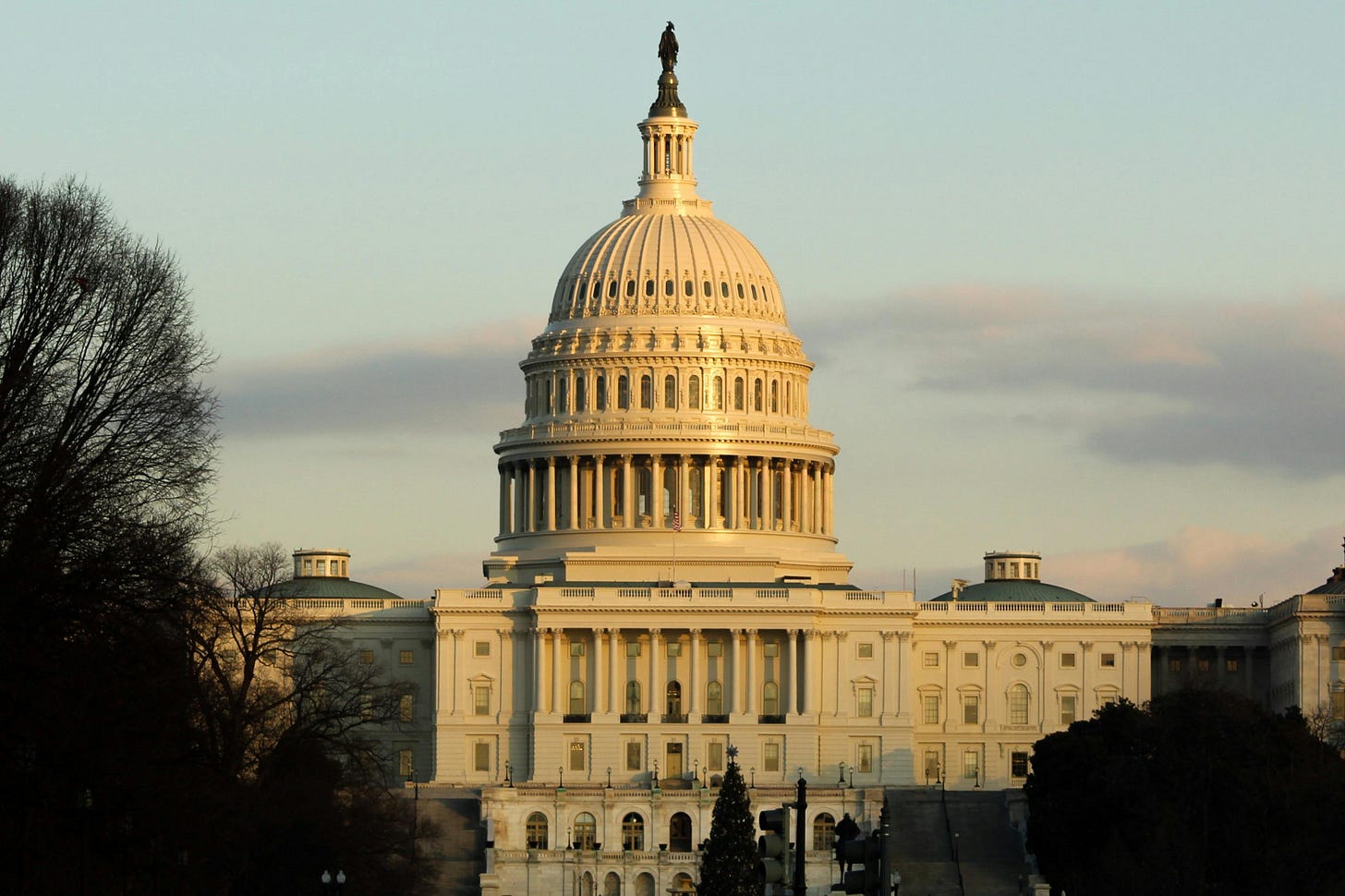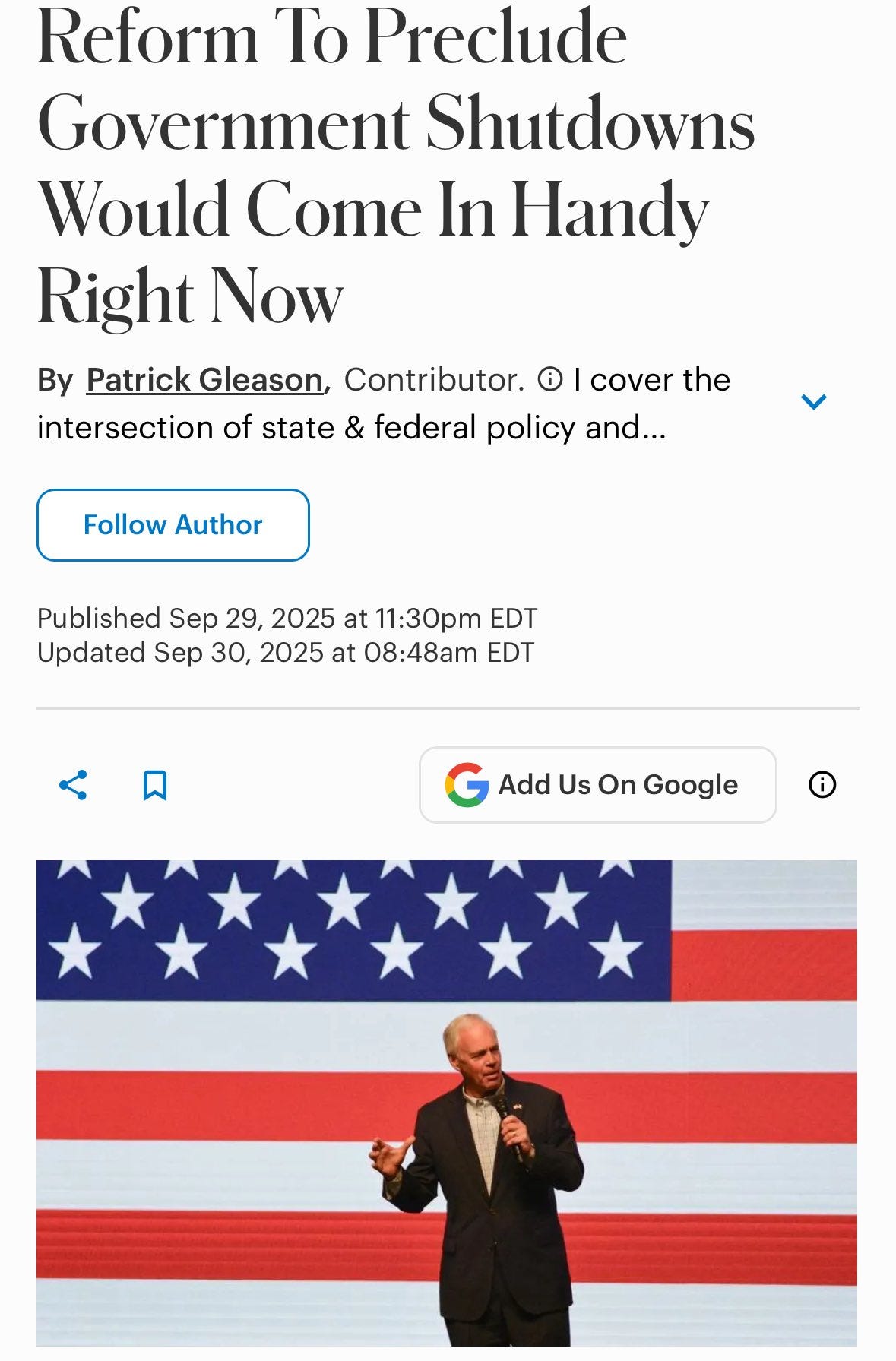Shutdown Showdown: Why Fiscal Discipline Can’t Wait | This Week's Economy Ep. 132
Shutdowns, tariffs, and micromanagement are dragging America off course. It’s time to trust markets and cut waste.
Hello Friends,
Washington is once again at a standstill. The latest federal shutdown is more than a partisan clash—it’s a reminder of how badly America needs real fiscal discipline. Endless spending battles, continuing resolutions, and bloated budgets have left taxpayers footing the bill for a government that refuses to live within its means. President Trump has warned of “irreversible” changes to the federal workforce during this shutdown, but the deeper problem isn’t staffing levels—it’s a budgeting process that’s broken at its core.
Sound economics goes beyond fiscal responsibility. Free trade, open markets, and competition—not tariffs, subsidies, or mandates—are what drive prosperity. From tariffs on movies and medicine to micromanagement of banking and biotech, Washington has drifted far from the principles that once made America the world’s economic leader. It’s time to rein in unnecessary spending, reject protectionism, and return to policies that let people prosper!
In this episode of This Week’s Economy, I’ll break down the latest news—from the shutdown to new Trump administration tariffs—and share solutions that can move us forward. Catch the full episode on YouTube, Apple Podcast, or Spotify, and visit my website for more information.
1. Federal Shutdown & Budget Blowout

In the News:
Last week, Congress failed to agree on a short-term deal to keep the government funded, triggering a partial federal shutdown. President Trump has warned that during this shutdown the administration could make “irreversible” changes to the federal workforce through new layoffs. Sources: CNBC and Fox News
My Take:
What the Shutdown Means: The shutdown will heighten partisan tensions and could trigger mass federal workforce layoffs. As Trump notes, spending cuts may bring some “good,” but the bottom line is clear: Americans don’t need more programs or promises. They need a budget they can afford—and a government that finally learns to live within its means.
Sustainable Budgeting Focus: The real question is when we’ll finally adopt sustainable budgeting. This fiscal rule caps appropriations to the rate of population growth plus inflation, with a supermajority vote required to exceed it. Colorado’s Taxpayer’s Bill of Rights pioneered a version of this approach—and it’s time Washington caught up.
Reforming the Budget Process: An automatic continuing resolution (CR) could help stabilize the budget process, but only if it comes with real teeth. Pairing an auto-CR with zero growth or even cuts—followed by sustainable budgeting—would restore fiscal discipline, protect taxpayers, and force government to live within its means.
Related Reading: I’m quoted on reforming the budget process in my Americans for Tax Reform colleague Patrick Gleason’s recent piece in Forbes.
2. Banking Regulations Are Too High

In the News:
Banking groups are warning that the CFPB’s Section 1033 “open-banking” rule—set to begin in April 2026—will force them to spend massive time and money on compliance systems for a rule that’s already tied up in legal challenges. Ballard Spahr
My Take:
What is Section 1033? Under CFPB Director Rohit Chopra, President Biden’s team has turned it into a sweeping data-access mandate. Banks must build APIs, grant wide third-party access, and run costly compliance programs. Supporters claim it empowers consumers and fuels competition. History shows the opposite.
It’s Bad Economics: Government mandates don’t spark innovation—they choke it. Section 1033 is a case study in red tape, rent-seeking, and regulatory capture. Smaller innovators get squeezed out, moral hazard is baked in, capital is misallocated, and regulatory creep is inevitable.
Trump’s Opportunity: President Trump now has the chance to stop the Section 1033 rule and go further by taking aim at the real culprit: Dodd-Frank. That law handed unelected bureaucrats sweeping power over credit, compliance, and consumer data. Rejecting Section 1033 is just triage. Repealing Dodd-Frank is the cure. The path forward is to trust markets, respect choice, and demand accountability.
Related Reading: I recently explained the harms of Section 1033 and why banks are fighting this.
3. Tariffs on Movies, What’s Next?

In the News:
The Trump administration is threatening 100% tariffs on foreign-made films. Existing tariffs—like those on lumber—are already worsening America’s housing affordability crisis. According to the Economic Freedom of the World report, the U.S. ranking on freedom to trade has plummeted from 8th in 1995 to 56th in 2023. If this new wave of tariffs continues, we could fall as low as 76th, pushing America out of the global top 10 in overall economic freedom. Sources: CNN, Fraser Institute, and New York Times
My Take:
No Justification for Tariffs: What national security threat comes from movies? None. Yet tariffs are being slapped on industries without cause. National security risks are nonexistent, but the economic risks will spread worldwide.
A Costly Mistake: Tariffs aren’t revenue drivers—they’re taxes on Americans. Higher costs ripple down supply chains, showing up as higher prices at the store, fewer jobs, slower wage growth, and weaker investment returns. For families already squeezed by inflation and rising housing costs, tariffs only pile on.
Next Steps: Congress must stop the executive branch from unilaterally raising taxes through tariffs. If America wants to stay a global leader, we can’t afford protectionism. The path forward is clear: roll back tariffs, shrink government’s footprint, and trust markets.
Related Reading: I recently wrote on America’s slipping economic freedom leadership.
4. Area Development Ranks States Misses the Full Picture

In the News:
A new ranking compares the best U.S. states to do business, based on site consultants’ assessments of cost of doing business, incentive programs, access to capital, workforce development, logistics, infrastructure, and regulatory climate. Source: Area Development
My Take:
Red vs. Blue: The top ten included many red states—Georgia, South Carolina, Texas, North Carolina, Tennessee, Ohio, Alabama, and Louisiana. The divide between red and blue states highlights how policy choices matter. Time and again, red states show that free-market principles fuel stronger growth and better jobs.
A Surprise Contender: Louisiana cracked the top 10 for the first time, ranking 9th. Job growth was modest at 1% over the past year, but GDP rose 4.0% in Q2—right at the national average. The energy sector, making up a quarter of the economy, gives Louisiana some of the lowest industrial electricity rates in the country—16% below the national average—an edge that draws manufacturing, petrochemicals, and data centers.
Improving Rank: Louisiana’s debut is a milestone worth celebrating, but rankings don’t guarantee prosperity. To turn momentum into long-term growth, the state must modernize its tax system, rein in spending, and strengthen workforce readiness. The lesson is clear: pro-growth policies matter in letting people prosper.
Related Reading: I unpack Louisiana’s progress—and what’s still needed—at the Pelican Institute.
5. Pharmaceutical Prices & Innovation

In the News:
President Trump has threatened a new 100% Section 232 tariff on branded drugs unless companies build plants in the U.S. At the same time, he announced a deal with Pfizer to sell its drugs directly to consumers at discounted prices through a new federal website, TrumpRx.gov. Sources: The Hill and NPR
My Take:
Markets Don’t Need Micromanagement: These policies may sound politically popular, but they’re economically damaging. America leads the world in biotech innovation not because of government command, but because private markets rewarded risk, protected intellectual property, and let patients—not bureaucrats—decide. The real threat to U.S. biotech leadership isn’t Beijing—it’s Washington’s turn toward micromanagement.
Impact of Policies: Tariffs are taxes, and taxes on medicine land on patients—through higher premiums, disrupted supply chains, or fewer cures. The American Hospital Association warned such tariffs could put patients “at significant risk.” PhRMA put it plainly: “Every dollar spent on tariffs is a dollar that cannot be invested in new treatments and cures.” Price caps, tariffs, mandates—it’s all the same story: more government control, less innovation.
The Choice: Drug development costs billions and takes a decade, with a 90% failure rate. Investors only take that risk if there’s a potential return. Cap the returns, pile on tariffs, and innovation dries up. America faces a choice: double down on price controls and bureaucracy—and hand biotech leadership to Beijing—or unleash competition, empower patients, and let people prosper.
Related Reading: Read my new piece in The Hill on U.S. biotech innovation and policy, drawn from my Americans for Tax Reform report.
Thanks for joining me in this episode of "This Week's Economy." For more insights, visit vanceginn.com and get even greater value with a paid subscription to my Substack newsletter at vanceginn.substack.com.
God bless you, and let people prosper!
Keep reading with a 7-day free trial
Subscribe to Let People Prosper to keep reading this post and get 7 days of free access to the full post archives.






